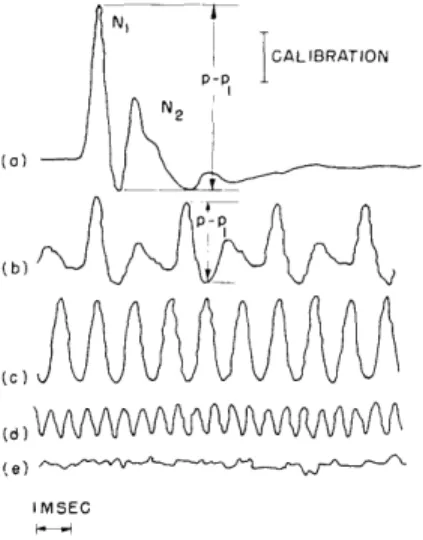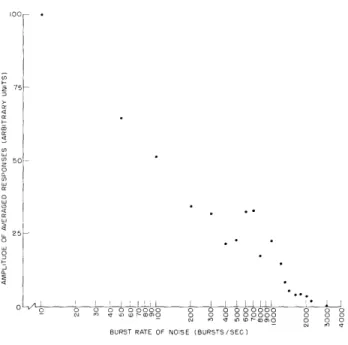XVI. COMMUNICATIONS BIOPHYSICS
Prof. W. A. Rosenblith Dr. N. Y-S. Kiang G. E. Forsen
Prof. M. H. Goldstein, Jr. Dr. T. T. Sandel Mrs. Margaret Z. Freeman Dr. J. S. Barlow* O. Gutierreztt C. D. Geisler
Dr. M. A. B. Brazier Aurice V. Albert C. E. Molnar Dr. Eda Bergert R. M. Brown D. F. O' Brien Dr. B. G. Farley A. H. Crist W. T. Peake
Dr. G. Gerstein**"" T. F. Weiss
A. ELECTROPHYSIOLOGICAL "STATE FUNCTIONS" AND THE HANDLING OF SENSORY INFORMATION (1)
The sensory performance of an organism and, in particular, the ability to make deci-sions that are related to sensory inputs depend in large part upon the "state" of his cen-tral nervous system. There are situations in which this "state" may have to be monitored either by the organism himself or by observers to whom data have to be transmitted over a communication link of limited capacity. A restricted set of rather gross "state vari-ables" must therefore be chosen that are (a) relatively easily measurable, and (b) can be studied in relation to significant physiological and psychological patterns of behavior. Given our lack of theoretical formulations for many of the processes involved, it is nec-essary to establish experimentally at least some of the properties of these pseudo state variables. Once candidates for such variables and appropriate displays have been chosen, further selection will depend upon factors such as: How stable is a given display for a given individual under comparable conditions ?; How sensitive is the display to important changes in the individual's environment?; and How well can a population be classified on the basis of a limited number of displays of a given state variable ?
Once some of the properties of such variables have been studied, it should be pos-sible to estimate more precisely what constitutes adequate sampling for such variables; and also what are the most appropriate computational methods when we are concerned with studying the electrical activity of the brain and, in particular, the potentials that are evoked by sensory stimuli.
W. A. Rosenblith References
1. Abstract of a paper presented at the Symposium on Possible Uses of Earth Satellites for Life Sciences Experiments, Washington, D. C., May 14-17, 1958.
From the Neurophysiological Laboratory of the Neurology Service of the Massachusetts General Hospital.
tPostdoctoral Fellow of the National Institute of Mental Health. IStaff Member, Lincoln Laboratory, M.I.T.
Postdoctoral Fellow of the National Institute of Neurological Diseases and Blindness. tDoherty Foundation Fellow.
(XVI. COMMUNICATIONS BIOPHYSICS)
B.
"STEADY-STATE"
AUDITORY NERVE RESPONSES TO BURSTS OF NOISE AT
DIFFERENT REPETITION RATES
In the study of auditory neurophysiology, major difficulties are encountered in
recording auditory nerve potentials with gross electrodes when acoustic stimuli are
presented at high repetition rates. First, response amplitudes decrease with increasing
repetition rate, so that at high rates the neural responses are extremely small. Second,
since the neural responses are small, it is difficult to avoid significant contamination
by low-level aural microphonics.
We have attempted to overcome these difficulties by
averaging (1) many responses on the computer ARC-1.
In the averaged response the
size of the neural components is increased relative to the noise. If clicks are used as
stimuli, the microphonic potentials will also be emphasized.
However, if bursts of
noise are used, averaging greatly increases the ratio of neural to microphonic potentials.
N, CALIBRATION (0) P-p (b) IMSEC
Fig. XVI-1.
Averaged responses to repeated bursts of noise. Electrode near round
window. The amplitude scale is not the same for different rates.
Peak-to-peak amplitudes (p - pl) are measured for the plot in Fig. XVI-2.
(C-480).
(a) Average of 500 responses for stimuli delivered at a
rep-etition rate of 10/sec.
Calibration line,
100 [ivolts.
(b) Average
of 500 responses at repetition rate of 400/sec.
Calibration
line,
50 4volts. (c) Average of 4000 responses at repetition rate of 1000/sec.
Calibration line, 50 4volts.
(d) Average of 4000 responses at
rep-etition rate of 2000/sec.
Calibration line, 25 tvolts.
(e) Average
of 4000 responses at repetition rate of 3000/sec.
Calibration line,
12.5
pvolts.
In this preparation no clear neural responses could be
detected at repetition rates above 2400/sec.
Responses to repeated bursts of noise were recorded from cats by means of gross electrodes placed either near the round window or in the internal auditory meatus. The duration of the bursts was 0. 1 msec in the electrical input to the earphone. In order to
100,
SVo 0 o o 00000 o 0 00 oooo
N W c 0 000000o
N r E O Dr- )00O
BURST RATE OF NOISE (BURSTS/SE)
Fig. XVI-2.
100 e_ -750 c IL uJw m a o 2 _ n o ooo ° D cmo-BURST RATE OF NOISE (BURSIS/SEG)
Fig. XVI-3.
117
0 0 0 00000 'T 0 0 000000 0 0 0 0 0
U)U))fU)A0 - 0 N 000000000 ')D)'-n0, 00 . 0 0 0 00
BURST RATE OF NOISE (BURSTS/SEC) I b)
Peak-to-peak amplitude versus stimulus repetition rate. Electrode near the round window. (C-480).
Peak-to-peak amplitude versus stimulus repetition rate for electrode locations: (a) near the round window; and (b) in the internal auditory meatus. The round-window response was taken between a wire electrode and the headholder. The internal-meatus response was taken from concentric elec-trodes. (C-483). i I I I I I I I o o0 0 0 o o 0 0 N ' 0 0 0 0 0 0 0 0 0 0 C) 0 C 0 0 0 0 0 0000 0000 I CC)
(XVI. COMMUNICATIONS BIOPHYSICS)
remain within the linear range of the ear, the intensity of the noise bursts was fixed at 25-35 db above the level at which responses at low repetition rates were just visually detectable on an oscilloscope screen. All animals were anesthetized with Dial.
In all instances the computing of averages started several seconds after the onset of the stimulus, i.e., when a "steady-state" of neural responses had been reached.
Figure XVI-1 shows samples of averaged responses for several repetition rates. Figures XVI-2 and XVI-3 show how the amplitude of neural responses varies as a func-tion of repetifunc-tion rate. The response amplitudes for repetition rates lower than 10 per second are nearly constant at these intensities of stimulation. The "bumps" on Figs. XVI-2 and XVI-3 for rates near 600 per second may result from the interaction of N1 and N2 components. The maximum rate at which synchronized activity is
detect-able is in the vicinity of 3000 per second. The curves of amplitude versus burst rate do not exhibit the plateaus obtained by Derbyshire and Davis for their "maximal
unequi-librated" neural responses at the onset of pure tones (2). Differences in technique and response criteria do not allow a direct comparison with their data.
W. T. Peake, M. H. Goldstein, Jr., N. Y-S. Kiang
References
1. W. A. Clark, Jr., Average response computer (ARC-1), Quarterly Progress Report, Research Laboratory of Electronics, M.I.T., April 15, 1958, pp. 114-117. 2. A. J. Derbyshire and H. Davis, The action potentials of the auditory nerve, Am. J.
Physiol. 113, 476-504 (1935).
ERRATA IN PREVIOUS REPORTS
In the Quarterly Progress Report of April 15, 1958, pages 115 and 116: Fig. XIV-2
should be Fig. XIV-3 and vice versa; the figure captions are correctly placed.
In the Quarterly Progress Report of July 15, 1958, page 182: Fig. XV-6 should be Fig. XV-7 and vice versa; the figure captions are correctly placed.

